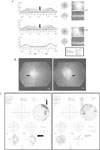Abstract
A 31-year-old woman was referred to our hospital for evaluation and management of poorly controlled epilepsy. The patient had been taking anti-epileptic drugs for six years. An MRI imaging study showed septo-optic dysplasia (SOD) and schizencephaly. SOD is a syndrome characterized by agenesis of the septum pellucidum or corpus callosum, optic nerve dysplasia and congenital hypothalamic-pituitary insufficiency. The patient was referred to the endocrine clinic for exclusion of any pituitary hormonal deficiencies. In a systemic review, the patient complained of polydipsia and polyuria for 20 years. In laboratory tests, measurements showed a serum osmolarity of 281 mOsm/kg, a serum sodium concentration of 144.7 mmol/L, a spot urine osmolarity of 183 mOsm/kg and a spot urine sodium concentration of 32 mmol/L. The patient underwent a water deprivation test, and was diagnosed with central diabetes insipidus.
We report a case of central diabetes insipitus combined with SOD, schizencephaly and epilepsy.
Figures and Tables
Fig. 1
Brain MRI showed schizencephaly (A) and absence of septum pellucidum (B and C). Arrows in picture A indicate closed lip type of schizocephalic clefts of lateral parietal regions in horizontal view, and arrows in picture B and C indicate absence of septum pellucidum in coronal view (B) and in sagittal view (C).

Fig. 2
Ophthalmologic examinations of the patient. (A) Optical coherence tomography showed partial optic nerve atrophy. Arrow indicates abnormal thin thickness of red-free retinal nerve fiber layer at nasal area. (B) Disc photography showed peri-papillary degeneration (arrows). C/D (Cup/Disc) ratio is 0.5 and it suggests optic nerve atrophy. (C) Visual field analysis showed right nasal side arcuate scotoma (black arrows) and left superior arcuate scotoma (white arrows) and this finding was compatible with optic nerve atrophy.

References
1. de Morsier G. Studies on malformation of cranio-encephalic sutures. III. Agenesis of the septum lucidum with malformation of the optic tract. Schweiz Arch Neurol Psychiatr. 1956. 77:267–292.
2. Skarf B, Hoyt CS. Optic nerve hypoplasia in children. Association with anomalies of the endocrine and CNS. Arch Ophthalmol. 1984. 102:62–67.
3. Melmed S, Jameson JL. Kasper DL, Braunwald E, Fauci AS, Hauser SL, Longo DL, Jameson JL, editors. Disorders of the anterior pituitary and hypothalamus. Harrison's Principles of Internal Medicine. 2005. 16th ed. Seoul: McGraw-Hill press;2077.
4. St John JR, Reeves DL. Congenital absence of the septum pellucidum: a review of the literature with case report. Am J Surg. 1957. 94:974–980.
5. Siatkowski RM, Sanchez JC, Andrade R, Alvarez A. The clinical, neuroradiographic, and endocrinologic profile of patients with bilateral optic nerve hypoplasia. Ophthalmology. 1997. 104:493–496.
6. Haddad NG, Eugster EA. Hypopituitarism and neurodevelopmental abnormalities in relation to central nervous system structural defects in children with optic nerve hypoplasia. J Pediatr Endocrinol Metab. 2005. 18:853–858.
7. Willnow S, Kiess W, Butenandt O, Dorr HG, Enders A, Strasser-Vogel B, Egger J, Schwarz HP. Endocine disorders in septo-optic dysplasia (De Morsier syndrome)-evaluation and follow up of 18 patients. Eur J Pediatr. 1996. 155:179–184.
8. Barkovich AJ, Fram EK, Norman D. Septo-optic dysplasia: MR imaging. Radiology. 1989. 171:189–192.
9. Kuban KC, Teele RL, Wallman J. Septo-opticdysplasia-schizencephaly. Radiographic and clinical features. Pediatr Radiol. 1989. 19:145–150.
10. Kim WJ, Yu YS, Chang BL. Septo-optic dysplasia. J Korean Ophthalmol Soc. 1991. 32:327–330.
11. Lee WH, Park SH, Shin H. A case of septo-optic dysplasia. J Korean Ophthalmol Soc. 1991. 32:332–338.
12. Han JW, Lee YC. De Morsier's syndrome expressed as congenital exotropia. J Korean Ophthalmol Soc. 1999. 40:869–874.
13. Parson SH, Dhillon B, Findlater GS, Kaufman MH. Optic nerve hypoplasia in the fetal alcohol syndrome: a mouse model. J Anat. 1995. 186:313–320.
14. Hoyt CS, Billson FA. Maternal anticonvulsant and optic nerve hypoplasia. Br J Opthalmol. 1978. 62:3–6.
15. Donat JF. Septo-optic dysplasia in an infant of a diabetic mother. Arch Neurol. 1981. 38:590–591.
16. McNay DE, Turton JP, Kelberman D, Woods KS, Brauner R, Papadimitriou A, Keller E, Keller A, Haufs N, Krude H, Shalet SM, Dattani MT. HESX1 mutations are an uncommon cause of septooptic dysplasia and hypopituitarism. J Clin Endocrinol Metab. 2007. 92:691–697.
17. Kim JM, Na DR, Park SH, Lee KW, Lee SB, Myung HJ. Two case of septo-optic dysplasia. J Korean Neurol Assoc. 1986. 4:255–259.
18. On KK, An JW, Myung NH, Kim JD. A case of septo-optic dysplasia. J Korean Ophthalmol Soc. 1993. 34:366–370.
19. Lam KS, Wang C, Ma JT, Leung SP, Yeung RT. Hypothalamic defects in two adult patients with septo-optic dysplasia. Acta Endocrinol. 1986. 112:305–309.




 PDF
PDF ePub
ePub Citation
Citation Print
Print



 XML Download
XML Download